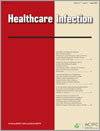HI11028Surveillance of surgical site infections after open heart surgery
Postoperative wound infections are a serious complication in open heart surgery leading to significant morbidity and mortality, prolonged hospitalisation and increasing costs of care. Of the 405 screened patients, surgical site infections occurred in seven patients (1.7%): two (0.5%) were superficial infections and five (1.2%) were deep infections. Post-discharge surveillance and antibiotic prophylaxis remain essential tools for the reliable assessment of surgical wound infections.


